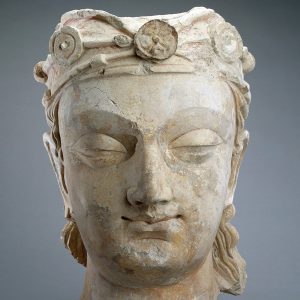Buddha: The Awakened One
The Buddha was born a prince in a kingdom on the border of Nepal and India in the fifth century BCE. Troubled by the inevitability of disease, aging, and death, he abandoned royal life to become a holy man. Six years of extreme self-discipline did not reveal a way to end the pain of existence. Finally, he sat under a tree, determined to acquire insight. His meditation led to the profound realization that attachments to impermanent things cause suffering. Through this enlightenment, he earned the designation Buddha, or “Awakened One.” The Buddha then taught others the path to overcome sorrow. In the centuries following his death, the Buddha’s teachings, or dharma, spread across Asia and became the foundation of Buddhism in all its forms. His life and image became central to Buddhist practice throughout the world.
Buddhas of the Past, Present, and Future
A buddha realizes the true cause of suffering and teaches the world how to overcome it. According to most Buddhist traditions, the Historical Buddha attained enlightenment through a process that had occurred countless times in the past. In every age, a remarkable individual rediscovers timeless truths and attains buddhahood. The buddha of the future awaits the chance to repeat the process.
Some traditions state that only one buddha may exist in an era. Others allow for many buddhas to be active in the world simultaneously. In the latter traditions, buddhahood is the goal for all humans, who seek assistance from the buddhas they worship.
As the number of buddhas grew, new forms of practice developed around specific buddhas. Because of their shared accomplishments, though, all buddhas are represented with the same physical characteristics.
Click on an image of a buddha below to learn more about it as a sacred object and an artwork.
Bodhisattvas: Travelers on the Path
The path to becoming a buddha is long and difficult. In most traditions, it takes countless lifetimes of exemplary virtue to achieve this goal. The journey to awakening begins with a sincere vow to become a buddha for the benefit of others. Those determined to follow this path to buddhahood are called bodhisattvas.
Motivated by profound compassion, bodhisattvas spend lifetimes perfecting their benevolent qualities, such as patience and wisdom. Because bodhisattvas have attained advanced spiritual states, they are able to assist others in worldly and religious matters. Thus, bodhisattvas are important objects of devotion for many Buddhists.
Artists typically depict bodhisattvas as radiant figures, richly adorned with jewelry. Bodhisattvas’ pristine beauty is an outward expression of their perfected inner virtues. It reflects the good karma they have garnered through innumerable virtuous deeds over many lifetimes.
Click on an image of a bodhisattva below to learn more about it as a sacred object and an artwork.
Keep Encountering the Buddha
Continue your exploration of Buddhist art across Asia. The Freer|Sackler features several exhibitions with Buddhist themes.
Home | Tibetan Buddhist Shrine Room | Worship in Sri Lanka | Hyecho: An Eighth-Century Pilgrim | Further Learning | For Kids










 Body Image: Arts of the Indian Subcontinent
Body Image: Arts of the Indian Subcontinent Center of the World: China & the Silk Road
Center of the World: China & the Silk Road Promise of Paradise: Buddhism in Medieval China
Promise of Paradise: Buddhism in Medieval China Looking Out, Looking In: Art in Late Imperial China
Looking Out, Looking In: Art in Late Imperial China Setting the Bar: Arts of the Song Dynasty
Setting the Bar: Arts of the Song Dynasty The Historical Buddha and Friends
The Historical Buddha and Friends